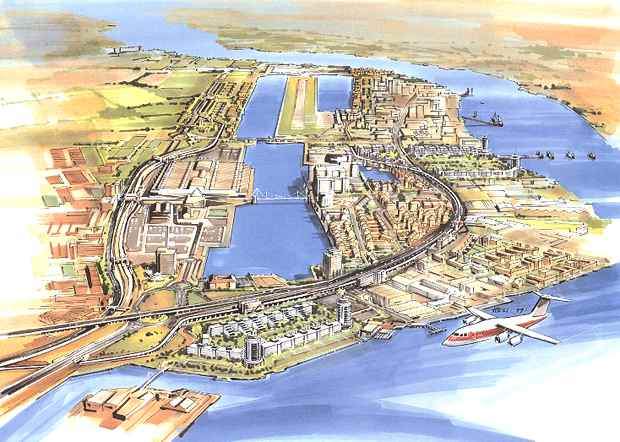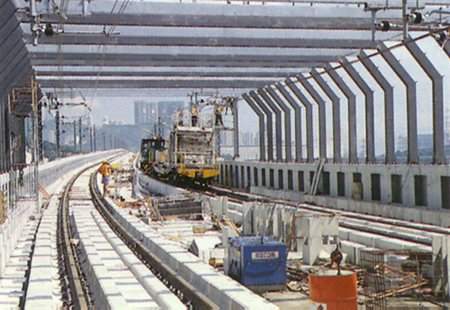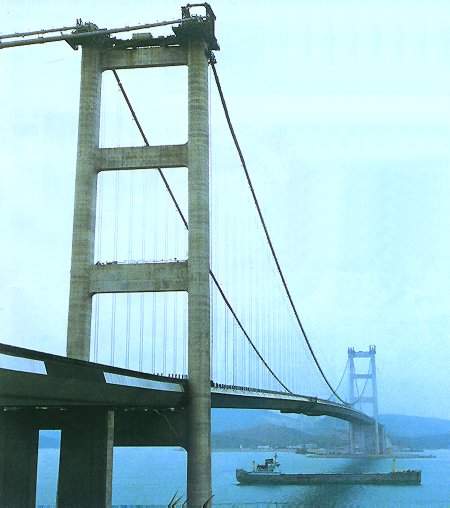Massive growth in Hong Kong’s importance as a trade and business centre brought about many problems for the island’s existing infrastructure. This in turn slowed down the rate of potential growth at a time when the territory was keen to exploit its position as a force on the world trading scene.
It was therefore seen as vital that the territory had modern transport facilities. The centrepiece of the development of these had been the new Chek Lap Kok airport.
A new 3.2km express magnetic-levitation line between Guangzhou and the Disney theme park at Sunny Bay, on the island of Lantau, was opened in 2006.
Two distinct lines using the 34km Airport Railway link
The new 34km Airport Railway, opened in July 1998, is used by two distinct services. Airport Express line offers a fast passenger link between Chek Lap Kok and central Hong Kong. Journeys take 24 minutes, with intermediate stops at Kowloon and Tsing Yi. It is served by seven-car trains, offering an all-seated, business class-type service.
Passengers travelling on the Airport Express line can check-in for their flights and receive boarding passes at the Hong Kong and Kowloon stations at no extra cost.
The Lantau line offers a more rapid transit orientated service, linking Lantau Island, West Kowloon and Hong Kong central. This serves six stations: Hong Kong, Kowloon, Tai Kok Tsui, Lai King, Tsing Yi and Tung Chung. Two additional stations, Airport and Asia-world Expo, were later built along the route. The Asia-world Expo station was opened in December 2005.
An interchange with the MTR (mass transit railway light rail system) is provided at Lai King. The introduction of this service brought two major benefits to the territory: traffic on the busy Nathan Road Corridor of the MTR was eased, while journey times between Lai King and Hong Kong central were slashed from 23 minutes to just eight-and-a-half.
Infrastructure of Hong Kong’s five different rail systems
Hong Kong has five different rail systems: the heavily-used MTR network, the busy suburban Kowloon Canton Railway, the modern light transit (LRT) system, a traditional street tramway and the peak funicular railway. Each operates independently, but there is considerable crossover between them.
Standard gauge lines are electrified at 1.5kV DC overhead, which gives total compatibility with the MTR system. Train speeds, a maximum of 135km/h (80mph), are considerably better than the 80km/h (50mph) which is the norm on MTR.
There are five intermediate stations on the two lines, some of which have separate, segregated platforms for Airport Express and Lantau line services. 8km of the new line is through tunnels, including an immersed tube under Victoria Harbour, plus a total of 6km (4 miles) is carried on elevated sections.
This includes the spectacular Tsing Ma suspension bridge, one of the territory’s biggest engineering projects of recent years. Among the world’s longest suspension bridges, it has a central span of 1,377m, which is one of the longest single spans of any bridge in the world.
With much of the line built on reclaimed land, the standard ballasted track can be shored up with additional material if required. However, tunnels, bridges and viaduct sections incorporate non-ballasted track on a concrete base, and in areas sensitive to noise pollution, floating slab track is used to cut noise and vibration.
The high frequency of services along the Airport Railway and Lantau lines places particularly heavy demands on the infrastructure. A British company is playing a prominent role in ensuring the line is kept in as good a running order as possible.
Free shuttle bus services are offered between Hong Kong and Kowloon Stations and major hotels in Hong Kong. Services are also offered to the Hung Hom station. Porter services are rendered at all stations, excluding Asia-world Expo, free of cost to aid passengers with baggage.
Rolling stock built by joint partners Adtranz-CAF
The contract for new trains to operate the services stipulated two distinct types of rolling stock for each service. However, the trains share a common aluminium-construction body design.
They are built by joint partners Adtranz-CAF, the former supplying traction and control equipment and a cab simulator for training purposes, with the latter the car bodies, bogies, interior fittings, air conditioning and auxiliary equipment. The trains were assembled in Spain, where static testing was also carried out. Final acceptance took place in Hong Kong.
The Airport Express line is served by a fleet of 11 seven-car trains whose facilities include a baggage car to carry luggage checked in at Hong Kong central or Kowloon stations. They also have two-plus-two upholstered seats – 64 to each car – carpets and luggage racks. Seat-back television screens provide up-to-date information on flights, MTR services and tourist information.
The Lantau line’s fleet comprises 12 trains, also each of seven cars, seating a total of 336 passengers, with standing room for 264 more in each car, important given the anticipated heavy use to which they were expected to be subjected.
Driverless trains with advanced automatic train technology, the first in Hong Kong, are employed on the Disneyland line. Two four-car trains operate with four-minute headway between the main line and the terminus at Sunny Bay. The target is to attract two million mainland tourists each year.
Signalling and communications along the Airport Express and Lantau lines
Signalling comprises three fully-integrated system packages. Trains are supervised automatically from a main control centre, while their movements are controlled and constantly monitored by a transmission-based automatic train control system and computer-controlled interlocking.
Stations are fitted with state-of-the-art communication and monitoring systems, including integrated passenger information displays (linked with those on the Airport Express trains), to provide up-to-the-minute travel information, on which details of any disruption to services can be displayed. Train drivers have two-way communication with their main control centre in the event of emergencies.
The contactless Octopus payment card is the heart of the public transport system. It can be used on all forms of public transport (except taxis) and increasingly other places, such as convenience stores, restaurants, vending machines and car parks.
Future for Hong Kong’s lines and expected growth
When fully operational, with the anticipated strengthening of the new trains, the Airport Express link and Lantau line are expected to carry around 250,000 passengers a day.
In order to cater for this anticipated growth, the trains are capable of being strengthened from seven to ten cars, boosting capacity by around 50%. The signalling system is capable of handling a greater service frequency than the initial eight-minute interval. Ultimately, this could be increased to one train every four-and-a-half minutes.










